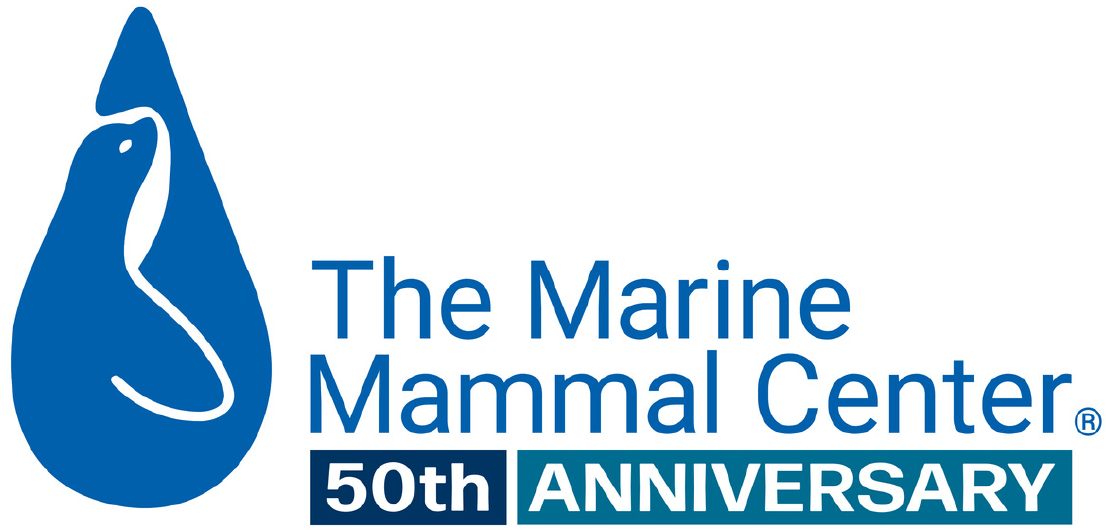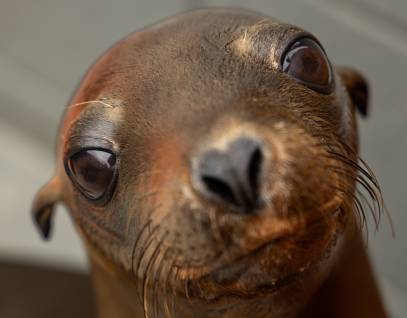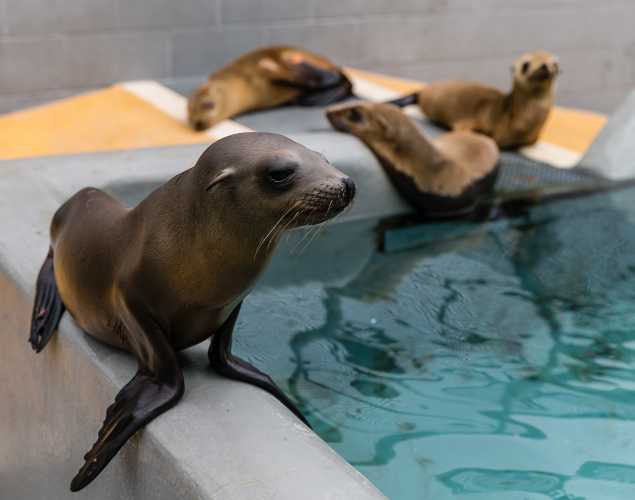
Young California Sea Lions Still Struggling to Survive
- Malnutrition
- Climate change
For the fourth year in a row, unusual numbers of starving young sea lions are stranding along California shores.
Spring has sprung and pup season has begun here at The Marine Mammal Center. For the last few weeks, our rescue trucks have brought in about a dozen new patients every day. And many of them are tiny, young sea lions struggling to survive.
The familiar scene evokes a sort of déjà vu feeling for our dedicated workforce as the days on the calendar seem to blur. This is the fourth year in a row that we’ve seen California sea lions in crisis.
Experts at NOAA Fisheries call it an “Unusual Mortality Event”—unusual because the sea lions are stranding much earlier in the year and in much higher numbers than the historic averages. In January and February of this year, California sea lion strandings along the California coast were almost four times higher than the average from 2003-2012.
And these animals are also unusually small. In addition to being dehydrated and emaciated—essentially fur-covered skeletons—they seem to be experiencing stunted growth early on in their development.
In many cases, our veterinary experts are having a difficult time determining the age of our incoming young sea lions. Nine-month-old pups are arriving in our care at little more than birth weight. And the animals born the year before them—in June of 2014—are the size of a typical pup, an entire year their junior.
“These sea lion pups and yearlings are so emaciated it’s surprising they had the strength to make it this far,” says Dr. Cara Field, The Marine Mammal Center’s staff veterinarian. “It’s clear that they’re fighting for their lives, but the toughest part of their journey is over and it’s our job to give them the extra help they need to get a second chance at life.”
To better understand what’s going on with these animals, we work closely with researchers from NOAA’s National Marine Mammal Laboratory to study the California sea lion population as a whole. For the last 40 years, these researchers have visited sea lion breeding areas in the Channel Islands to count pups and take measurements. And this year, pup weights are the lowest ever documented and the number of pup births are down from 2015.
Understanding the Crisis
Although there’s still much to learn about the complex and interconnected causes of this unusual mortality event for our California sea lions, experts believe the root cause is related to food availability—or the lack of it, especially for nursing mothers.
For more than a year now, unusually warm waters have been lingering off the coast of California, causing temperature-sensitive fish to move northward or offshore to cooler waters. Experts say the warm waters, dubbed “the blob,” have been triggered by a domino effect of abnormal climatic conditions, such as changes in wind, current and upwelling patterns.
The El Niño conditions that have developed over the past year have caused these warm waters to persist. Although experts predict these conditions will weaken over the next few months, the waters off the California coast are still warmer than usual.
And these warm waters can have significant impacts throughout the food web, disturbing the entire coastal ecosystem. Throughout the Center’s 41-year history, we’ve typically seen higher numbers of marine mammal strandings during El Niño years as the ecosystem changes affect fish populations and increase stress on the animals.
But the “El Niño effect” doesn’t explain why California sea lions have been struggling since 2013. New research suggests that a decade-long trend of declining fish populations in the waters near sea lion breeding areas may also be to blame.
NOAA Fisheries scientists analyzed changes in sea lion prey and found that high-calorie sardines and anchovies, both rich in fat that is vital to the growth of young sea lions, have declined in the last 10 years in the areas near the Channel Islands, where nursing mothers search for food.
This may have forced these mothers to go after market squid and rockfish instead, which contain less fat and fewer calories. While adult males and females without pups may be able to survive on a low-calorie diet, nursing mothers and their pups need more substantial nourishment.
Experts say environmental shifts are likely causing the changes in fish populations and distribution. And while similar declines have occurred during previous El Niño events, the spike in sea lion strandings began before the current El Niño pattern took hold and even before the warm water “blob” began to form.
So while researchers may better understand why nursing mothers and their pups are struggling, we still don’t have a good sense of when this crisis will end.
“After four years of sea lions in crisis, the initial shock of seeing so many starving sea lions is over and now we’re really starting to worry about long-term impacts on the population as a whole,” says Dr. Shawn Johnson, Director of Veterinary Science at the Center.
One Patient at a Time
As our experts look at the bigger picture to learn more about how a changing ocean is impacting sea lion populations, they also know that it’s important not to lose sight of the individual patient—and we’re able to learn from each and every one.
During the sea lion crisis we faced last year at this time, our veterinary and animal care experts made a number of adjustments to formula recipes, feeding schedules and medications based on what they were learning as they cared for these incredibly malnourished young animals.
For example, they began using a product called Emeraid that has been successfully used to stabilize sick seabirds. This powder containing amino acids, protein, vitamins and minerals is mixed with water, helping rehydrate our patients while delivering life-saving nutrients—almost like Gatorade or Ensure for sick sea lions.
After a record-breaking year of rescues in 2015, our volunteer crews began training new volunteer help early in the year, before the typical busy season. That way, teams were already working well together and had the skills and people-power necessary to handle another crisis this year.
What’s even more challenging for our dedicated workforce of animal care volunteers is that these starving young sea lions aren’t the only hungry mouths they need to keep fed. We’re also right in the thick of peak harbor seal and elephant seal pup season, with more than 187 patients on-site today.
As pupping season continues, it’s important to remember that the best thing you can do for these wild animals is to leave seals be by keeping your distance and alerting the experts if you see a seal in distress. For marine mammals along the California coast from Mendocino County to San Luis Obispo, call The Marine Mammal Center’s hotline at 415-289-SEAL (7325).
Yes, I want to save a life!
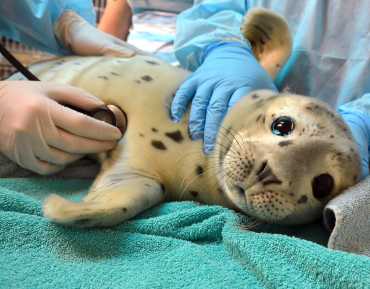
Yes, I want to save a life!
You’ll be giving sick and injured animals the best possible care at the Center’s state-of-the-art hospital. With your gift today, you are giving a patient a second chance at life in the wild.
See Our Latest News
{"image":"\/Animals\/Patients\/Harbor seals\/2020\/cropped-images\/hs-barnwood-by-bill-hunnewell-c-the-marine-mammal-center-315-0-3299-2577-1607370547.jpg","alt":"harbor seal Barnwood","title":"Last-Minute Gift Guide \u2013 Top Gifts that Give Back to Marine Animals","link_url":"https:\/\/www.marinemammalcenter.org\/news\/last-minute-gift-guide","label":"News Update","date":"2025-12-18 01:00:00"}
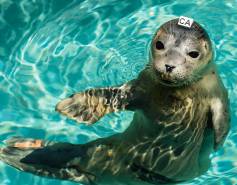
Last-Minute Gift Guide – Top Gifts that Give Back to Marine Animals
December 18, 2025
Read More{"image":"\/Animals\/Patients\/Hawaiian monk seals\/2025\/cropped-images\/b-ru72admission-to-ke-kai-ola112125photo-c-the-marine-mammal-center-noaa-permit-24359-0-364-1270-992-1766095407.jpg","alt":"A newborn Hawaiian monk seal pup with a black coat in rehabilitative care.","title":"Newborn Hawaiian Monk Seal Pup Now Receiving Care","link_url":"https:\/\/www.marinemammalcenter.org\/news\/newborn-hawaiian-monk-seal-pup-now-receiving-care","label":"Patient Update","date":"2025-12-18 01:00:00"}

{"image":"\/Animals\/Patients\/Hawaiian monk seals\/2025\/cropped-images\/d-ru28release-exam-at-ke-kai-ola111025photo-by-giancarlo-rulli-c-the-marine-mammal-center-noaa-permit-24359-0-0-1270-992-1764620886.jpg","alt":"","title":"Bird Flu Vaccine Trial Offers Hope for Protecting Hawaiian Monk Seals","link_url":"https:\/\/www.marinemammalcenter.org\/news\/bird-flu-vaccine-trial-may-offer-hope-for-protecting-hawaiian-monk-seals","label":"News Update","date":"2025-12-01 08:13:00"}

Bird Flu Vaccine Trial Offers Hope for Protecting Hawaiian Monk Seals
December 1, 2025
Read More{"image":"\/Animals\/Patients\/Hawaiian monk seals\/2021\/hms-pp08-by-sheila-latta-c-the-marine-mammal-center-noaa-permit-18786.jpg","alt":"Hawaiian monk seal","title":"The New York Times: Inside the Bird-Flu Vaccine Trial for Monk Seals","link_url":"https:\/\/www.marinemammalcenter.org\/news\/the-new-york-times-inside-the-bird-flu-vaccine-trial-for-monk-seals","label":"In the News","date":"2025-12-01 01:00:00"}

The New York Times: Inside the Bird-Flu Vaccine Trial for Monk Seals
December 1, 2025
Read More